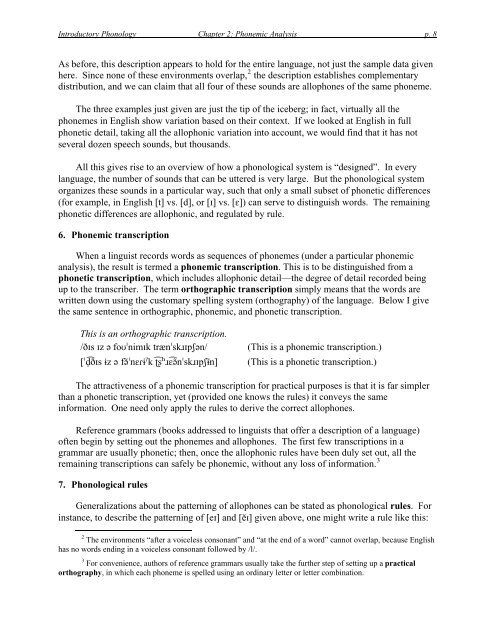Introductory Phonology - UCLA Department of Linguistics
Introductory Phonology - UCLA Department of Linguistics
Introductory Phonology - UCLA Department of Linguistics
Create successful ePaper yourself
Turn your PDF publications into a flip-book with our unique Google optimized e-Paper software.
<strong>Introductory</strong> <strong>Phonology</strong> Chapter 2: Phonemic Analysis p. 8<br />
As before, this description appears to hold for the entire language, not just the sample data given<br />
here. Since none <strong>of</strong> these environments overlap, 2 the description establishes complementary<br />
distribution, and we can claim that all four <strong>of</strong> these sounds are allophones <strong>of</strong> the same phoneme.<br />
The three examples just given are just the tip <strong>of</strong> the iceberg; in fact, virtually all the<br />
phonemes in English show variation based on their context. If we looked at English in full<br />
phonetic detail, taking all the allophonic variation into account, we would find that it has not<br />
several dozen speech sounds, but thousands.<br />
All this gives rise to an overview <strong>of</strong> how a phonological system is “designed”. In every<br />
language, the number <strong>of</strong> sounds that can be uttered is very large. But the phonological system<br />
organizes these sounds in a particular way, such that only a small subset <strong>of</strong> phonetic differences<br />
(for example, in English [t] vs. [d], or [] vs. [ɛ]) can serve to distinguish words. The remaining<br />
phonetic differences are allophonic, and regulated by rule.<br />
6. Phonemic transcription<br />
When a linguist records words as sequences <strong>of</strong> phonemes (under a particular phonemic<br />
analysis), the result is termed a phonemic transcription. This is to be distinguished from a<br />
phonetic transcription, which includes allophonic detail—the degree <strong>of</strong> detail recorded being<br />
up to the transcriber. The term orthographic transcription simply means that the words are<br />
written down using the customary spelling system (orthography) <strong>of</strong> the language. Below I give<br />
the same sentence in orthographic, phonemic, and phonetic transcription.<br />
This is an orthographic transcription.<br />
/ðs z ə foʊˈnimk trænˈskɹpʃən/ (This is a phonemic transcription.)<br />
[ˈd̪ ͡ðs ɨz ə fə̃ˈnɛɾɨʔk ʈ͡ʂʰɹɛ͡əñˈskɹpʃɨñ] (This is a phonetic transcription.)<br />
The attractiveness <strong>of</strong> a phonemic transcription for practical purposes is that it is far simpler<br />
than a phonetic transcription, yet (provided one knows the rules) it conveys the same<br />
information. One need only apply the rules to derive the correct allophones.<br />
Reference grammars (books addressed to linguists that <strong>of</strong>fer a description <strong>of</strong> a language)<br />
<strong>of</strong>ten begin by setting out the phonemes and allophones. The first few transcriptions in a<br />
grammar are usually phonetic; then, once the allophonic rules have been duly set out, all the<br />
remaining transcriptions can safely be phonemic, without any loss <strong>of</strong> information. 3<br />
7. Phonological rules<br />
Generalizations about the patterning <strong>of</strong> allophones can be stated as phonological rules. For<br />
instance, to describe the patterning <strong>of</strong> [e] and [ĕɪ] given above, one might write a rule like this:<br />
2 The environments “after a voiceless consonant” and “at the end <strong>of</strong> a word” cannot overlap, because English<br />
has no words ending in a voiceless consonant followed by /l/.<br />
3 For convenience, authors <strong>of</strong> reference grammars usually take the further step <strong>of</strong> setting up a practical<br />
orthography, in which each phoneme is spelled using an ordinary letter or letter combination.

















